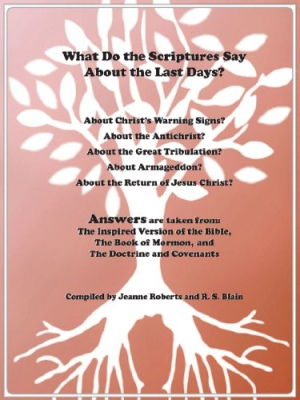What Do the Scriptures Say about the Last Days?
Written from an evangelical standpoint, What Do the Scriptures Say about the Last Days? relies on three prominent theological sources to present a fundamentalist’s interpretation of the biblical Armageddon. This is a guide with excerpts from The Inspired Version of the Bible, The Book of Mormon, and The Doctrine and Covenants.
This reference tool is intended to encourage reading about and critical pursuit of the subject. The book consists of fifteen chapters which the authors have divided into two parts, plus an appendix with emergency instructions (to prepare readers for the cataclysmic event) and suggested study materials.
Roberts and Blain have taken a literal view of the Second Coming of Christ, an approach that will appeal to an audience immersed in similar beliefs. The authors assert that as biblical predictions come true and signs of the foretold end of the world manifest themselves, the inevitable outcome, as told of in the book of Revelation, will occur. Roberts and Blain accept this as God’s truth, not as a matter for discussion or debate.
Social problems, religious wars, and natural phenomena are addressed in detail and woven into an intricate fabric of personal faith that welcomes prophesied changes while, at the same time, it fears others: “The Antichrist will gain absolute control over most of the world.” Formatted like a workbook, illustrated, and relying heavily on excerpts, this is a compilation of information that the authors place into a predetermined doctrinal grid. The authors begin with a broad concept and tend to force their ideas into a belief system that not even all Christians may accept as valid. From this perspective, the reasoning and logic are subject to intense scrutiny.
The primary author, Jeanne Roberts, has been a member of the Reorganized Church of Jesus Christ for more than fifty years. She holds a master’s degree from Central Michigan University, and this is her third book. R. S. Blain is a compiler and illustrator.
A tendency to preach like a minister of a specific church rather than take the stance of a scholar who acknowledges countless possible interpretations of world events gives the book a negative tone, even if not intended. The result is a dire warning as opposed to an open-minded examination. Though not extremist in content, this “guide” barrels down one predestined road with no brakes.
Reviewed by
Julia Ann Charpentier
Disclosure: This article is not an endorsement, but a review. The publisher of this book provided free copies of the book and paid a small fee to have their book reviewed by a professional reviewer. Foreword Reviews and Clarion Reviews make no guarantee that the publisher will receive a positive review. Foreword Magazine, Inc. is disclosing this in accordance with the Federal Trade Commission’s 16 CFR, Part 255.

